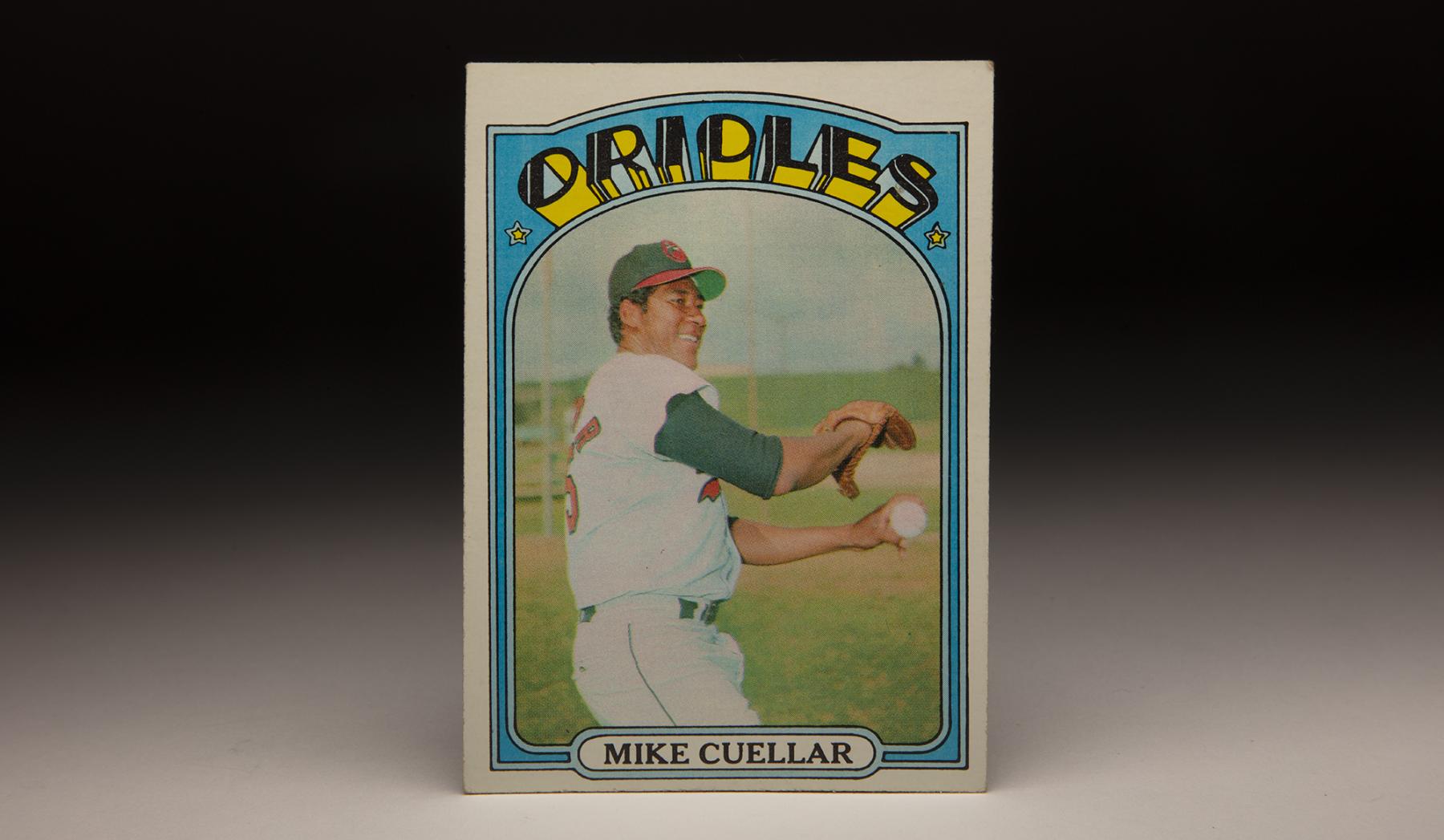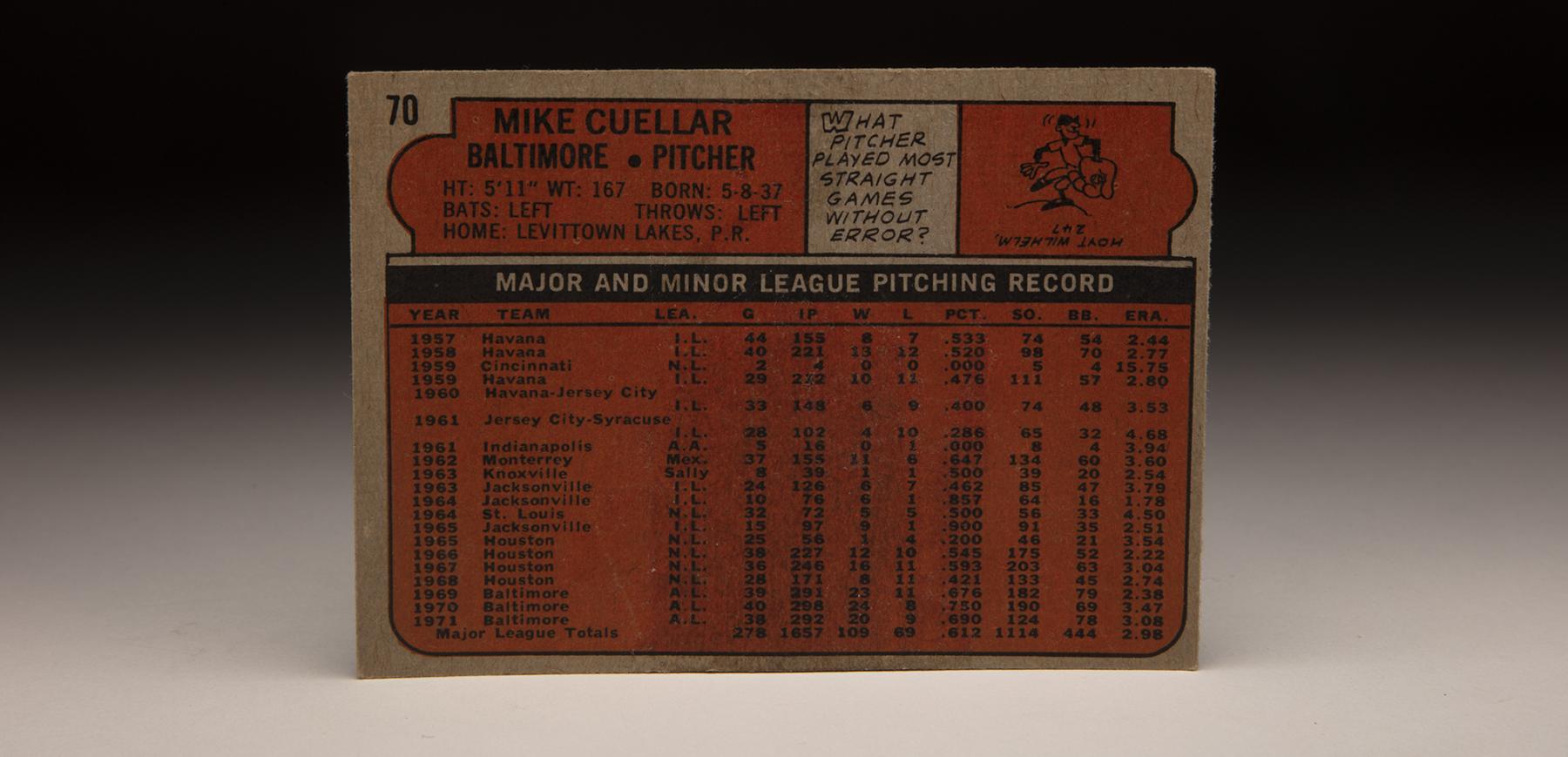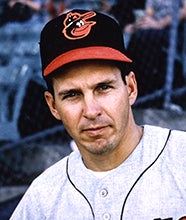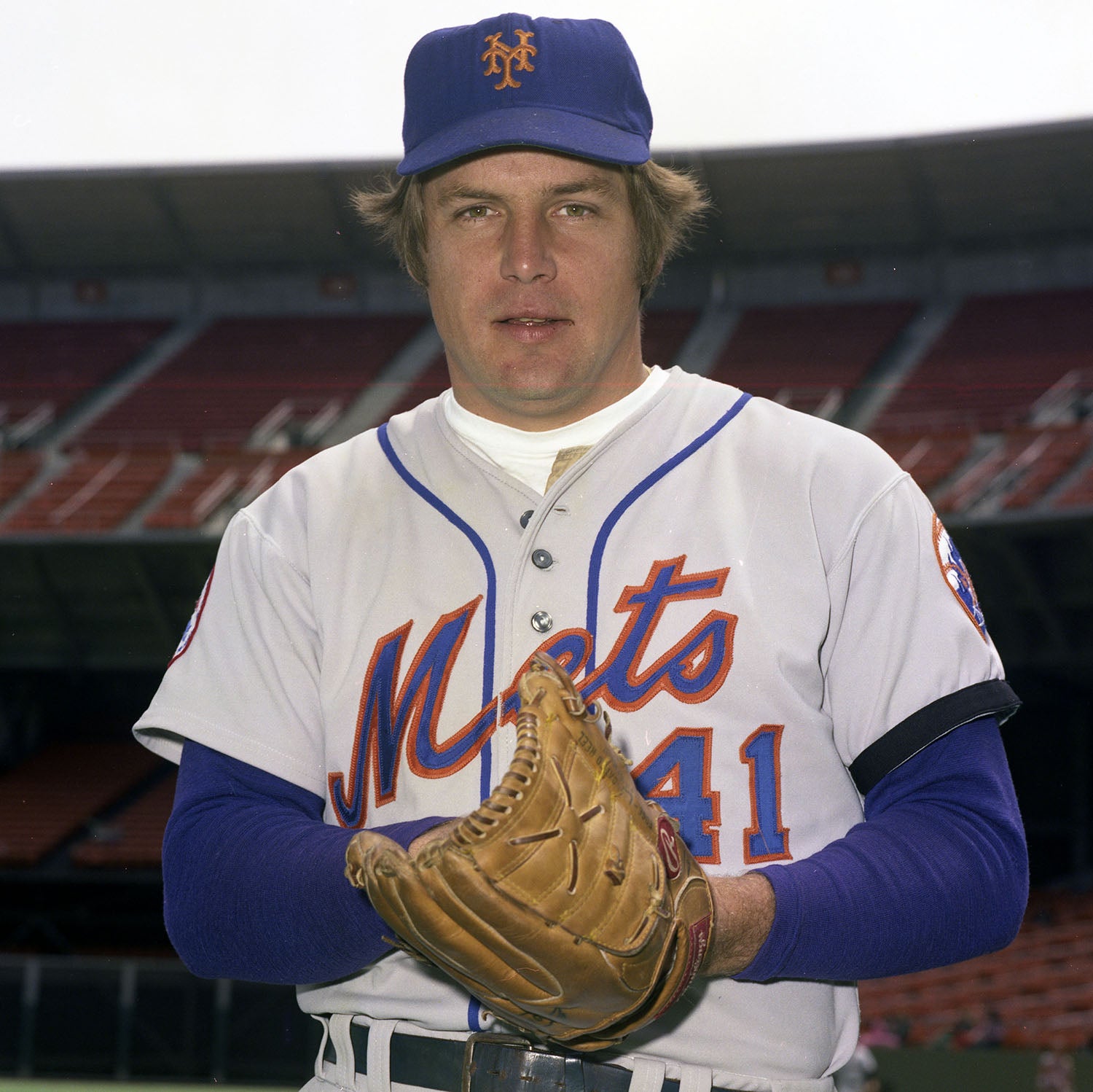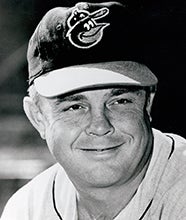- Home
- Our Stories
- #CardCorner: 1972 Topps Mike Cuellar
#CardCorner: 1972 Topps Mike Cuellar
Superstitions were a way of life for Mike Cuellar, who would not deviate from a routine once he found it successful.
While pitching the Baltimore Orioles to five postseason trips in six seasons, Cuellar had more success than any other left-hander in the game.
Cuellar’s quirks were famous throughout baseball – thanks in part to the Orioles’ winning ways that kept them on the national stage for years. He would only warm up with Orioles coach Jim Frey catching, and during warm-ups Orioles catcher Elrod Hendricks – and no one else – had to take a batting stance to simulate a batter. Cuellar insisted on picking up his glove and the ball from the ground – he would not catch either thrown by any player – and he would circle the mound at the start of each inning.
Orioles Gear
Represent the all-time greats and know your purchase plays a part in preserving baseball history.
But whatever the method, it worked for Cuellar, who won more games (125) than any other lefty in the game from 1969-74, one fewer than MLB leader Fergie Jenkins.
Born May 8, 1937, in Las Villas, Cuba, Cuellar escaped work in the sugar cane fields by enlisting in the Cuban army, where he showed off his powerful left arm on the mound. He pitched for a Nicaraguan League team in 1956 during an era where players like Jim Kaat and Zoilo Versalles also played in that league, then spent a successful season in the Cuban Winter League in the winter of 1957.
Soon after, the Cincinnati Reds signed Cuellar and assigned him to the Havana Sugar Kings of the International League. Facing Triple-A pitching at just 20 years of age, Cuellar was 8-7 with a league-low 2.44 ERA. After posting a 13-12 mark in 1958, the Reds named Cuellar to their Opening Day roster in 1959. But after two relief appearances where he allowed seven earned runs over four innings, Cuellar was returned to the Sugar Kings.
He would not appear in another big league game for five seasons.
Cuellar was 10-11 with a 2.80 ERA for Havana in 1959, pitching the Sugar Kings to a spot in the Little World Series against the Minneapolis Millers of the American Association. Cuellar pitched in three of the games, with Havana winning Game 7 in a Cuban nation that had just undergone a revolution that put Fidel Castro in power.
“In the deciding game in Havana, Fidel came to the bench and asked who I was going to pitch,” Havana manager Preston Gómez, a native of Cuba, told the Associated Press. “He said: ‘If you need any help, just call me.’”
Gomez did not have to call on Castro, who pitched for several years in Cuba before beginning his political life. But with gunfire audible in the streets outside the stadium, many players feared for their safety.
Cuellar returned to the Sugar Kings in 1960, but the team was moved to Jersey City during the season due to travel restrictions in Cuba. Cuellar spent the 1961 season in the minors and then pitched for Monterrey of the Mexican League in 1962 before his contract was acquired by the Cleveland Indians prior to the 1963 season. He was 7-8 with a 3.49 ERA in two minor league stops that year before the St. Louis Cardinals bought his contract for 1964.
Now 26 years old, Cuellar finally discovered the pitch – a screwball he learned in the winter leagues from former big leaguer Rubén Gómez – that would propel him to stardom.
“Gómez threw it better than I do,” Cuellar told United Press International in 1970, “but I know that I can catch right-handed batters off guard with it – although I’m proud of my fastball. I believe the screwball has enabled me to be a success in the big leagues, but I consider my fastball my out pitch and I think it’s better than I get credit for.”
Starting the 1964 season with Triple-A Jacksonville, Cuellar went 6-1 with a 1.78 ERA in 10 starts. On June 15, the Cardinals reshaped their roster for the next decade by acquiring Lou Brock from the Cubs in a deal that sent Ernie Broglio, Doug Clemens and Bobby Shantz to Chicago. The next day, the Cardinals called up Cuellar to replace Shantz in the bullpen.
Cuellar spent the rest of the season in the big leagues, going 5-5 with a 4.50 ERA in 72 innings as a spot starter and reliever. St. Louis won the National League pennant and then defeated the Yankees in the World Series, but Cuellar was one of two pitchers on the Cardinals’ Fall Classic roster who did not appear in any of the seven games as St. Louis captured the title.
Then in the spring of 1965, the Cardinals sent Cuellar back to Jacksonville, where he went 9-1 with a 2.51 ERA in 15 appearances before being sent to the Astros with Ron Taylor on June 15 in exchange for Chuck Taylor and Hal Woodeshick. Cuellar was 1-4 with a 3.54 ERA with Houston – mostly as a reliever. But in 1966, the Astros put Cuellar in their starting rotation, where he went 12-10 with a sparking 2.22 ERA over 227.1 innings. Only Sandy Koufax had a better ERA among NL pitchers.
In 1967, Cuellar was named to his first All-Star Game and pitched two scoreless innings in the Mid-Summer Classic in Anaheim in a game the National League won 2-1 in 15 innings. He finished the season with a 16-11 record and a 3.03 ERA, striking out a career-best 203 batters.
In the Year of the Pitcher in 1968, however, Cuellar went 8-11 with a 2.74 ERA. And when the Orioles offered Curt Blefary and a minor leaguer for Cuellar and two other players, the Astros sent their left-hander to Baltimore on Dec. 4, 1968.
“Cuellar had some trouble with his arm last year and it cut back on his effectiveness for a while,” Dick Hall, who would team with Cuellar in Baltimore from 1969-71, told the Baltimore Sun following the trade. “He probably has one of the best screwballs you’ll find anywhere, and he knows how to pitch.”
Cuellar proved Hall to be correct in 1969, going 23-11 for an Orioles team that won 109 games en route to the AL East title. Cuellar was 13-1 in his first 14 appearances after the All-Star Game as the Orioles took control of the division.
Working 290.2 innings, Cuellar posted a 2.38 ERA and drew the Game 1 starting assignment in the first-ever ALCS against the Twins. Cuellar allowed two earned runs over eight innings as Baltimore won 4-3 in 12 innings – with Hall picking up the victory.
After sweeping the Twins, the Orioles faced the Mets in the World Series. Cuellar again started Game 1, outdueling Tom Seaver in a 4-1 win while pitching a complete game. Cuellar returned to start Game 4, receiving a no-decision after allowing one run over seven innings. The Mets would win that game on an error in the 10th inning – and clinch the title the next day in Game 5.
Cuellar, though, had more fall excitement in store that year. On Nov. 6, Cuellar and the Tigers’ Denny McLain finished in a tie for the AL Cy Young Award. It remains the only tie in Cy Young Award voting history.
Cuellar and the Orioles proved not to be one-year wonders in 1970, as the left-hander went 24-8 for a league-best .750 winning percentage. Cuellar also led the AL in games started (40) and complete games (21) as Baltimore again won the AL East, posting 108 victories.
Cuellar started Game 1 of the ALCS and Games 2 and 5 of the World Series, posting no decisions in the first two outings but throwing a complete game in his second start of the Fall Classic – inducing the Reds’ Pat Corrales to ground out to third for the final out of the Orioles’ five-game victory.
Cuellar surrendered three runs in the top of the first inning in Game 5, but shut out the Reds the rest of the way on just two hits – abandoning his trademark screwball because it was ineffective.
“After that first inning, I got loose and had great stuff,” Cuellar told UPI on a day he battled cool and rainy weather in Baltimore. “I couldn’t get the screwball over (the plate), so I threw fastballs and sliders.”
In 1971, Cuellar and the Orioles won their third straight AL pennant, as Cuellar went 20-9 as one of four Baltimore pitchers – along with Pat Dobson, Dave McNally and Jim Palmer – who reached the 20-win plateau. Only the 1920 White Sox had ever matched that mark.
But after throwing a six-hitter in Game 2 of the ALCS en route to a sweep of the Athletics, Cuellar lost both his decisions against the Pirates in the World Series – including a hard-luck, 2-1 defeat in Game 7 where he allowed just four baserunners over eight innings.
Cuellar retired the first 11 Pittsburgh batters in Game 7 before allowing a home run to Roberto Clemente that gave the Pirates the lead for good.
The Orioles won 318 regular season games from 1969-71. Cuellar was credited with 21 percent of those victories.
Baltimore’s dynasty ended in 1972, but Cuellar was as effective as ever. He won 18 games in both 1972 and 1973, with the Orioles recapturing the AL East title in the latter season before falling to Oakland in the ALCS. Cuellar then went 22-10 in 1974, leading the league with a .688 winning percentage and earning his fourth-and-final All-Star Game berth.
At age 37, Cuellar seemed to get better as he aged.
“His screwball makes his fastball that much better,” said Elrod Hendricks, who caught Cuellar for nine seasons in Baltimore. “He’s the only guy in the league who throws a good one.”
But Cuellar’s workload – he averaged 278 innings per season from 1969-74 – appeared to catch up with him in 1975, as he went 14-12 with a 3.66 ERA, his highest mark since becoming a full-time starter in 1966. Then in 1976, Cuellar lost seven of his first nine decisions. A notoriously slow starter who always seemed to heat up with the weather, Cuellar was given a long leash by Orioles manager Earl Weaver. But after falling to 4-12 following a loss on July 24, Cuellar was dropped from the rotation.
“I respect everything he’s done here,” Weaver told the Associated Press.
Weaver, who loved Cuellar’s tenacity, used Cuellar sparingly down the stretch in 1976. On Dec. 21, 1976, the Orioles released Cuellar.
He hooked on with the Angels in 1977, but allowed seven earned runs in 3.1 innings over two appearances that spring before drawing his release on May 16. He would pitch in the Mexican League and in the winter leagues well into his 40s, but Cuellar’s big league career was over.
After staying active in the game as a coach and instructor, Cuellar passed away on April 2, 2010.
“He was an artist,” Weaver told the Orlando Sentinel the day of Cuellar’s passing. “He could pitch a game in 85 pitches, and he might not throw his best fastball twice. That’s the kind of pitcher he was. He knew how to pitch, and he knew how to get people out.”
Cuellar finished his career with a record of 185-130 with a 3.14 ERA and 1,632 strikeouts.
In a career filled with highlights, his peak came when he pitched the Orioles to the Fall Classic title in 1970, embracing World Series MVP Brooks Robinson on the field after recording the final out.
“Mr. Cuellar,” Orioles teammate Boog Powell said after Game 5, “I would like to present you with the game ball.”
Cuellar, putting superstition aside, took the ball from Powell and kissed it.
“I love this game,” Cuellar said.
Craig Muder is the director of communications for the National Baseball Hall of Fame and Museum
Related Stories

#CardCorner: 1972 Topps Jose Pagan

#CardCorner: 1972 Topps Bob Oliver
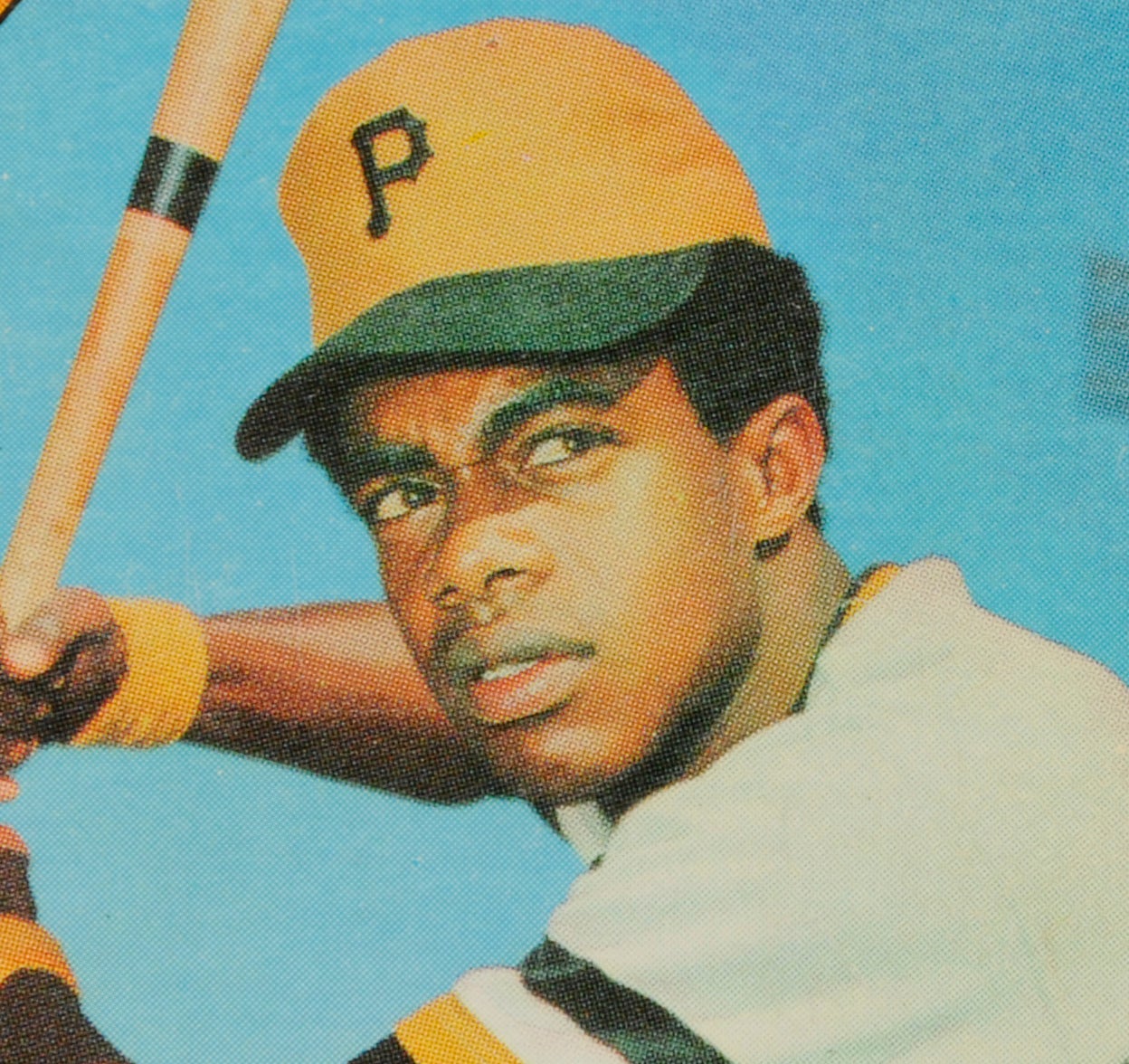
#CardCorner: 1972 Topps Dave Cash

#CardCorner: 1972 Topps Jose Pagan

#CardCorner: 1972 Topps Bob Oliver


